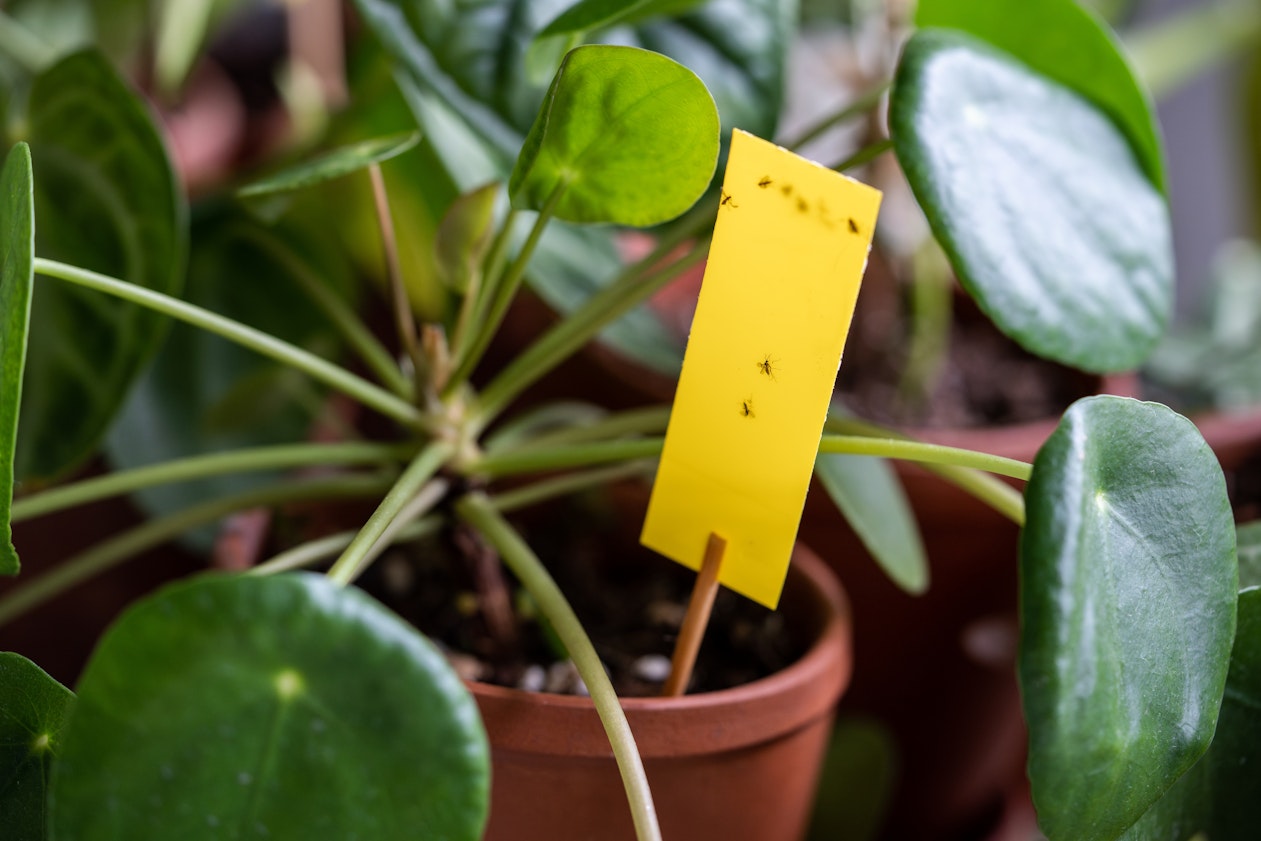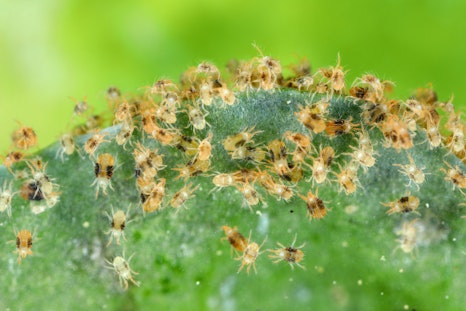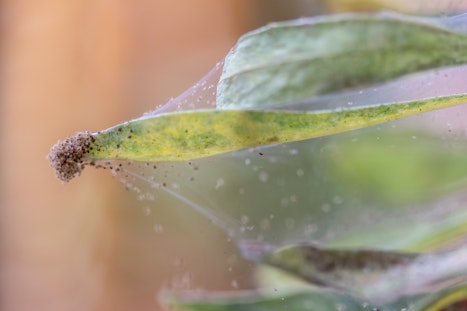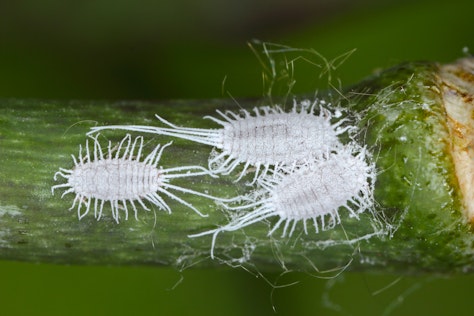
- Home
- How to Get Rid of Flies on Indoor Plants

We’ve all been there... It’s 7:30, you’re finally sat on the sofa after a long day of working hard. Tea in one hand and remote in the other, flicking through countdown reruns and cooking shows. Then you spot it... right there, directly in your eye line.
A tiny little black speck, lumbering around, seemingly floating towards you. Then you spot another. Then another. Then another. Wait, is that one a different colour? Another! Another!
As a plant keeper, this is a common issue. These lumbering specks are known as ‘fungus flies’, most commonly: fungus gnats (Sciaroidia), which are tiny, thin black flies, and fruit flies (Drosophila melanogaster), which are a little larger, with golden bodies and bright red eyes.
These infuriating little beasts are present across most temperate parts of the world and thrive in environments similar to those in your houseplant soil. While they do not pose any immediate threat to the health of your plants, they do disrupt the harmony of your soil and their presence can be an indicator of problems with your plant’s health.
In this blog, you’ll find a concise guide to the common fungus flies, and how to get rid of them and prevent them in the future!
Understanding the Life Cycle of Flies
Interrupting these pesky flies at multiple points in their life cycle is the key to removing them from your home. Both fruit flies and fungus gnats enter the home, usually through an open window or as a passenger on something brought into the house, and fly around searching for fungi.
These fungi are usually found on rotting food, kitchen sink plugholes, waste bins and unfortunately, in the soil of your favourite plants.
When finding a source of delicious fungus, they lay their eggs, which promptly hatch and consume it, before developing into mature flies and leaving their homes to find a mate and repeat the cycle. Unfortunately, fungus flies have no understanding of the importance of genetic diversity, and are quite happy to reproduce with members of their immediate family.
This, their enormous egg clutches (fungus gnats: 200-300, fruit flies 400-500) plus their short lifespans (fungus gnat: 10 days, fruit fly: 40-50 days), mean that a single pregnant fly can very quickly turn into metric tonnes if not kept in check.
Identifying the Causes of Fly Infestation
There are a number of things to consider when searching for the root of your fly infestation. Below are a few of the most common factors contributing to the presence of fungus flies.
Moisture and Humidity
Leaving your soil damp breeds soil humidity, which creates a number of problems. Firstly, it creates a perfect, humid environment for the incubation of fly eggs, ensuring a higher yield of success for the large numbers of fly eggs in the soil. Secondly, it creates a hospitable environment for fungi for them to eat.
There are, at any one time, thousands of fungal spores in the air in most places. Spores are unlikely to ever germinate without landing in a hospitable environment, which just happens to be cold, damp, dark places stuffed full of organic matter (like roots) and nutritious microbiomes.
While fungus in your soil is not inherently terrible, and particular fungi are actually really good for your plant, any significant surplus will usually lead to an increase of flies as a result.
Dead Leaves and Plant Debris
Organic matter is fungus food. Any kind of excess plant matter, such as rotten roots or leaves, can increase the amount of fungus growing in your soil, which creates more food for fungus fly larvae.
Removing dropped leaves from your soil is imperative to reduce the possibility of fungal spread in your soil. It's important to know that the main body of fungus exists as thin strands under the ground pretty much everywhere called mycelium, and the mushrooms that you see peeking out of the forest floor are just a reproductive organ.
A single strand can grow quickly throughout a space if given adequate food and hospitable conditions. It is imperative to use fresh soil in your houseplants for this reason, among many others.
How to Get Rid of Flies on Indoor Plants
Here are some methods you can implement to remove flies from your indoor plants:
Removing Infested Soil
In cases where fungus flies have been isolated to a few plants, usually indicated by a large presence of them when shaking the plant pot or disturbing the surface of the soil, a quick solution would be to completely remove the soil from the roots.
Remove the plant from its container, rinse the root ball under low pressure, room temperature tap water and gently massage the roots until all the soil is removed. Wash and dry the container and repot the plant with fresh, dry, well-draining soil.
Using Dish Soap Solution
A dish soap solution can help reduce the number of mobile fungus flies in the home. Mix a solution of about 100 ml of warm water, two teaspoons of sugar, two tablespoons of apple cider vinegar or any fermented yeast drink (beer/cider) and then about 6 drops of washing-up liquid. If left out, the sweet liquid will attract the flies, but upon landing on it the dish soap will be too viscous for them to fly away.
Sticky Traps
Yellow or blue sticky traps, like the dish soap solution, help to remove fungus flies from the air. The traps' bright colour mimics flowers, which attracts the nectar-loving flies who upon landing are stuck and unable to fly away.
Organic Solutions
Specific species of nematodes and various microbes digest and eat fungus fly larvae. These can be purchased from specialist shops and are mixed with water and applied directly to the soil.
These microscopic creatures live and reproduce in the soil, eating the larvae as they grow in number. Once there is nothing left for them to eat, they die. These solutions are pet and family-friendly, and actually redistribute the nutrients from the larvae back into the soil to be absorbed by your plants!
Keeping Soil Dry
Letting soil dry out can help to create an inhospitable environment for fungus fly larvae, and helps to reduce the growth of fungus in the soil for them to eat.
This is certainly a more important solution in the wintertime when soil stays damp for longer. Developing a conscious watering schedule means that soil can be left to dry without damaging any plants.
Proper Plant Care
Ensuring your plant is as healthy as possible can seriously reduce the risk of a fungus fly infestation. Sufficient watering schedule and an appropriate potting mix can ensure that the soil doesn’t hold too much water.
Further, feeding and providing your plant with enough light ensures the plant grows healthily. It can also reduce leaf dropping and reduce the risk of root rot, helping to maintain a healthy soil microbiome and ensuring there is no prolific growth of unwanted fungus.
Finally, the pruning and removal of dead or dying leaves reduces the amount of organic matter in the soil, helping to inhibit unwanted fungus growth.
Conclusion
So, when tackling fungus flies it is important to take a multi-pronged approach. Tackling the larvae in the soil using organic methods or soil changes, while fighting the mobile flies in the air using traps can help halt the life cycle at multiple points. This can ensure that the fungus flies around your home can’t reproduce or lay eggs, and those in your soil can’t mature and become fungus flies.
As always, the best way to ensure no pests bother your plants (or you!) is to develop a healthy and conscious plant care routine, that keeps your plants growing happy and healthy!
Jonathan Davies
Jonny has worked at Root since May 2023. His love for plants was inherited initially from his grandparents and parents, but really took off once he moved into his own place, where he started picking up small plants and was fascinated by watching how they grow and change over time. Jonny has a degree in Archaeology and Classics from the University of Sheffield, and a masters in Egyptology from Swansea University, where he primarily focused on garden culture in the ancient world, which he has managed to extend to a PhD thesis in the University of Liverpool, where he has been able to combine his love for plants with his love for ancient language and culture. Jonny loves being in the natural spaces around North Wales and Cheshire where he used to go growing up, and often spends hours examining the plants and trees, and kicking up the leaf litter searching for mushrooms and insects. He is fascinated most by plant biology, taxonomy and learning about ecosystems and interactions between plants and their environmental counterparts, and enjoys tending to his varied array of houseplants, and ongoing ‘plant projects’, such as growing plants from seeds and creating living epiphyte displays. Aside from his green thumb, his other interests include: art, reading, listening to and playing music in the company of his cats, Spooky and Boo.
More by Jonathan DaviesRelated Articles
View all articles



